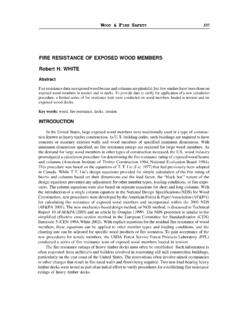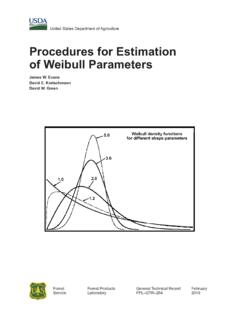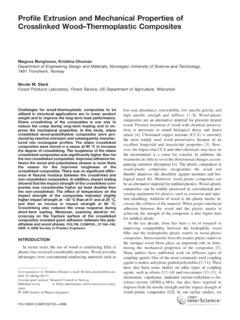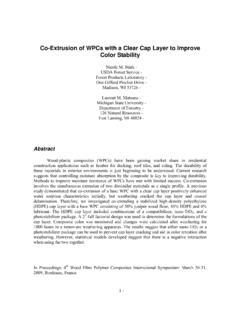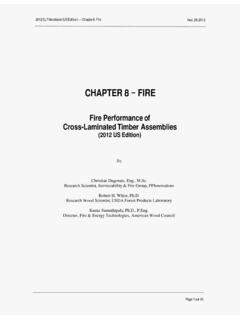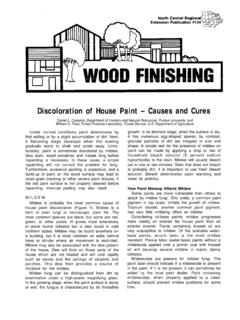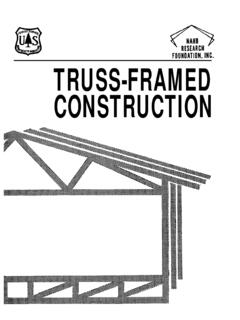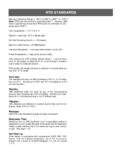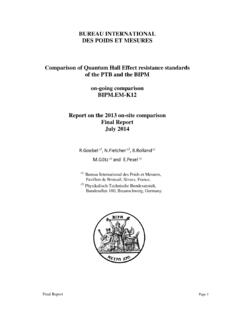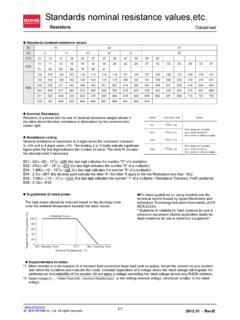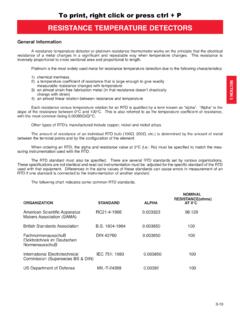Transcription of STRENGTH OF SINGLE-POLE UTILITY STRUCTURES …
1 Chapter 4 STRENGTH OF SINGLE-POLE UTILITY STRUCTURES INTRODUCTION SINGLE-POLE UTILITY STRUCTURES are generally loaded as cantilever beam-columns. Their load capacity varies with geometry, structural mate rial, manufacturing process, and support conditions. These parameters, often characterized with varying degrees of uncertainty, are used with mechanics-based as well as empirical-based models (that also introduce some uncertainty) to obtain load capacity or resistance estimates. For these reasons, the design procedure described in Chapter 2 incorporates resistance factors ( factors in Eq. 2-1a) to account for the uncertainties inherent in the estimates of pole capacity. pole resistance is a random variable that may be characterized using a probability density function (PDF).
2 For the typical range of pole resistance and load coefficients of variation (COVs), a relatively consistent reliability can be achieved across material types by setting nominal resistance values that represent a 5% to 10% lower exclusion limit (LEL) equal to the design load effect corresponding to a predetermined return period (RP) (IEC 2002; Peyrot and Dagher 1984). For example, setting the 5th percentile pole STRENGTH , R5%LEL' equal to the 50-year RP load effect Q50, R5%LEL = Q50, yields resulting reliabilities that are relatively insensitive to the respective PDFs and COVs of the load and STRENGTH parameters. In this manual, nominal resistance (Rn) is defined as the STRENGTH that will be exceeded by 95% of poles in the target population (see Fig. 1-1 in Chapter 1).
3 In statistical terms, this value is often referred to as the 5th per centile (5% of the population lies below it) or the lower 5% LEL. Because it is not practical to require a precise evaluation of the 5% LEL, statistical methods are commonly used to obtain an estimate that has an associated level of confidence. Confidence refers to the probability that a randomly selected sample will have an LEL greater than or equal to the target value . The lower confidence bound on a LEL is called a lower tolerance limit (LTL). In this manual, we refer primarily to a 5% LTL having a 50% or 75% confidence. 35 36 RELIABILITY-BASED DESIGN OF UTILITY pole STRUCTURES OBJECTIVE This section presents three basic methods for deriving and document ing Rn as an LTL value along with the coefficient of variation (COVR) for SINGLE-POLE STRUCTURES .
4 These include the following: 1. An empirical analysis based primarily on tests of full-sized poles. 2. A theoretical analysis of mechanics-based models used in conjunction with Monte Carlo simulation. 3. A default assignment of material distribution parameters. These three approaches are intended to address the range of com plexity and experience associated with conventional as well as potential UTILITY pole structural materials. The empirical approach relies heavily on test data to verify modeling assumptions. This is especially appli cable for wood that is a nonuniform orthotropic material. The variable nature of wood leaves the designer with the options of using a mini mum clear wood STRENGTH and designing to the minimum specification (for example, largest knot, minimum dimension, greatest grain angle), or referencing full-scale tests of a sample of poles that represent the quality range expected when ordering to a minimum specification ( , ANSI [ANSI 2002]).
5 If the critical stress in a wood pole occurs predominantly at the groundline and does not involve knots, STRENGTH can be predicted using distribution parameters published for clear wood (ASTM 1998). Knots, cross-sectional dimensions, and taper may present some questions about variability; in such cases a full-scale pole test database may provide a better estimate of the Rn for full-sized poles. The uniform, isotropic nature of materials such as steel and concrete make them more amenable to the use of mechanics-based models. These models may be coupled with Monte Carlo simulation of material proper ties to predict their 5% LTL STRENGTH . In other cases, where model param eters exhibit little or no covariance the analytical models may be used to estimate mean behavior, and independent parameter variances may be summed to provide an estimate of the pole STRENGTH variance with no need for computer simulation.
6 Default assignment is used when there are insufficient data to char acterize the pole STRENGTH PDF empirically and when demonstrably reli able models have not been developed to provide accurate estimates of structural performance for a particular pole material or configuration. The default method provides a conservative approach to assigning parameters for estimating Rn. Market forces will likely control the evolution of the reliability-based design (RBD) approach and ultimately bring all pole configurations to a STRENGTH OF SINGLE-POLE UTILITY STRUCTURES 37 relatively uniform level of reliability. It is the responsibility of the pole suppliers to provide the parameters and supporting documentation for their poles strengths, but it is the responsibility of the design engineer to select the correct pole for a given load condition.
7 It is the responsibil ity of the purchasing agency to review and verify that the poles selected by the engineer are provided by the pole supplier. If competing suppliers are unsure of values being used by their competition, it is their responsi bility to fully understand the competitive products and their evaluation. It is this system of checks and balances resulting from competition and documented system performance that will force evolution of increasing reliability. SCOPE The following discussion is related to the derivation of resistance PDFs for SINGLE-POLE STRUCTURES subjected to transverse wind and ice loading. In this application, the primary structural component (the pole ) is con sidered to behave as a cantilever beam. Its resistance is characterized by a bending- STRENGTH PDF, although the actual failure mechanism may be a localized buckling or tensile failure.
8 Procedures outlined in this section rely on the fundamental assumption that all poles meet or exceed established minimum manufacturing and process quality standards for poles (AISC 1999; ANSI 2002; ANSI/ASCE Standard 10-90 [ASCE 1992], which was previously ASCE Manual 72 [ASCE 1990]; PCI 1999]). The organizations that set these standards provide for acceptable tolerance variations in the manufacturing or processing of all of the pole types. A pole s nominal STRENGTH shall be determined and reliability-based STRENGTH factors shall be calculated against these accept able variations. This document does not address pole STRENGTH reliability associated with initial substandard quality poles or of pole deterioration because of damage in service or use in hostile environments. pole dete rioration, whether cumulative or due to a single event, is highly variable and should be handled as part of regular pole inspection and maintenance schedules.
9 CHARACTERIZING pole STRENGTH This document does not cover all possible design criteria for SINGLE-POLE STRUCTURES . It illustrates general methods to assign nominal design properties for common pole configurations. The general procedures out lined here can be adapted to less-common designs. 38 RELIABILITY-BASED DESIGN OF UTILITY pole STRUCTURES Loads As previously noted, loads considered in this characterization of pole STRENGTH are limited to wind and ice. While the magnitude variablility of these loads are different within and between geographic regions, their effect is manifested on SINGLE-POLE STRUCTURES predominantly as cantilever-bending moments. Potential failure modes that result from bending vary with pole material type, geometrry, and suupport conditions. All potential failrue modes must be considered in deriving a PDF to characterize pole STRENGTH . For wood poles, extreme fiber-bending stress generally con trols the pole 's bending load capacity.
10 For reinforeced concrete poles, the ultimate STRENGTH is often controlled by the compressive STRENGTH of the concrete. For tubular steel and fiber-reinforced polymer (FRP) STRUCTURES , local buckling and bending are generally the governing factors. nominal resistance To achieve relatively uniform structural reliability across all material types, a uniform definition of characterstic of nomianal STRENGTH or resistance Rn is required. resistance or STRENGTH (Rn ) defined in terms of a limiting stress should represent a consistent estimate with regard to the STRENGTH PDFs for all pole materials. To this end Rn for SINGLE-POLE STRUCTURES is herein defined to represent the 5% LEL with a noted level of confidence (= LTL), regardless of material type. The following discussion describes three approaches to characterizing pole STRENGTH and identifiying: 1. The nominal resistance Rn corresponding to a designated LTL.
